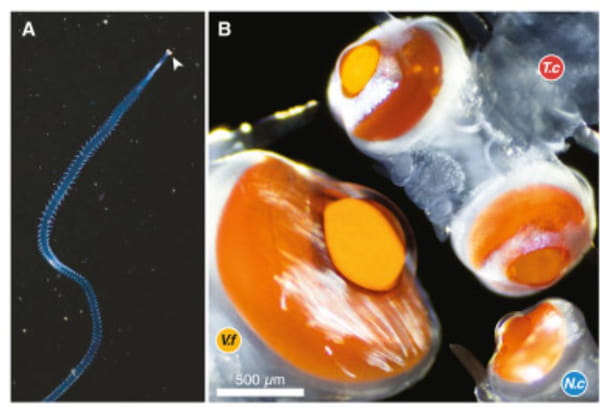This worm has huge eyes but it’s not for nothing.
In the abysses of the Mediterranean resides a tiny creature, almost insignificant if researchers had not been interested in its sight. This animal is called the annelid worm Vanadis formosa. From the polychaete family, it is distinguished by its enormous orange-red eyes which, together, weigh twenty times the weight of its head. Transposed onto a human, our eyes would weigh nearly 50 kilos each.
The appearance of the Vanadis worm is already known to researchers, but a team of biologists from the University of Copenhagen (Denmark) and the University of Lund (Sweden) are interested in a study to the reasons which pushed evolution to provide this creature of the seabed with such eyes. “We want to understand why this almost invisible worm that lives and hunts in the depths of the night evolved to have such large eyes,” explains Michael Bok, a biologist at Lund University in Sweden. “First, we wanted to know if the size of his eyes had a positive impact on his vision.”

The first results made it possible to understand how these worms hunted. Thanks to their eyes, they are able to spot small objects and track their movements. A discovery that surprises researchers because this capacity is usually reserved for vertebrates, arthropods (insects, spiders, etc.) and cephalopods (octopuses, squid). This is, according to Anders Garm, a biologist at the University of Copenhagen, “the first time that a vision has been so advanced and detailed beyond these groups”.
Although it has a tiny brain, the Vanadis would therefore have eyesight comparable to that of mammals. But for the moment, it remains difficult to explain why evolution has endowed this species from the ocean floor with such highly developed visual acuity. Especially since such a view implies the presence of large orange-red lenses which, unlike its transparent body, makes it visible and therefore more vulnerable to predators.
In 1977, research on Vanadis formosa had already concluded that the species was able to detect ultraviolet rays. From these two studies, Swedish and Danish biologists founded the theory that “worms are themselves bioluminescent and communicate with each other thanks to the light that emanates from them […]using ultraviolet rays, they therefore remain invisible to other species”. And continues by explaining “that they could have developed this UV vision in order to have a secret language linked to mating”. This is in in any case the first time that UV bioluminescence has been observed in a species.
